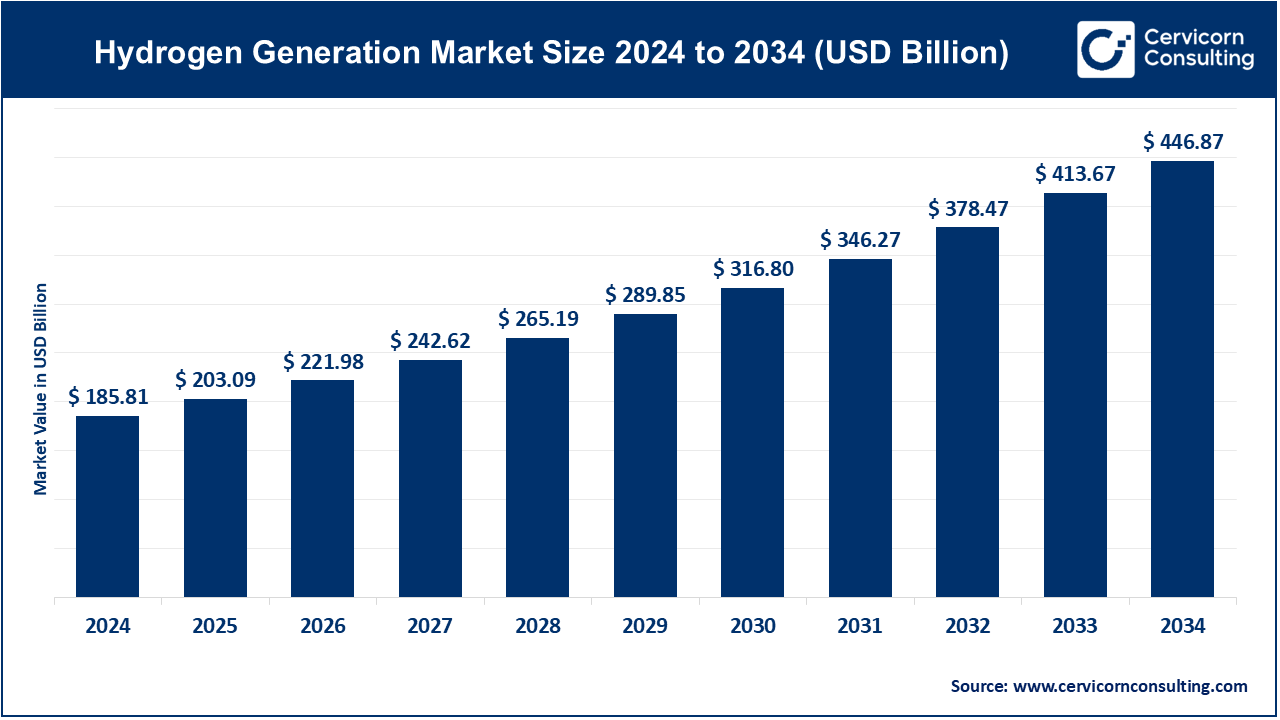Hydrogen Generation Market Size
The global hydrogen generation market was valued at USD 185.81 billion in 2024 and is projected to reach USD 446.87 billion by 2034, growing at a CAGR of 9.3% from 2025 to 2034.
What is the Hydrogen Generation Market?
The hydrogen generation market encompasses the production, distribution, and utilization of hydrogen as a clean energy source. Hydrogen, the most abundant element in the universe, holds significant promise as a sustainable alternative to fossil fuels. It can be produced through various methods, including:
-
Steam Methane Reforming (SMR): A widely used technique involving the extraction of hydrogen from natural gas.
-
Electrolysis: Splitting water into hydrogen and oxygen using electricity, with the potential for green hydrogen when powered by renewable energy sources.
-
Coal Gasification: Converting coal into hydrogen and other by-products.
-
Biomass Gasification: Producing hydrogen from organic materials.
The market’s significance lies in hydrogen’s versatility across various sectors, including transportation, power generation, and industrial applications, contributing to global decarbonization efforts.
Get a Free Sample: https://www.cervicornconsulting.com/sample/2344
Market Trends
-
Shift Towards Green Hydrogen: There’s a growing emphasis on producing hydrogen using renewable energy sources, aiming to reduce carbon emissions and promote sustainability.
-
Technological Advancements: Innovations in electrolyzer technologies are enhancing the efficiency and scalability of hydrogen production, making it more economically viable.
-
Integration with Renewable Energy: The coupling of hydrogen production with renewable energy sources, such as wind and solar, is gaining momentum, allowing for energy storage and grid stabilization.
-
Development of Fuel Cell Technologies: Advancements in fuel cell technologies are expanding hydrogen’s applications, particularly in transportation and stationary power systems.
-
Government Initiatives and Policies: Many governments are implementing policies and providing incentives to promote hydrogen adoption, recognizing its role in achieving climate goals.
Market Dynamics
Drivers:
-
Environmental Concerns: Increasing awareness of climate change is driving the demand for cleaner energy solutions like hydrogen.
-
Energy Security: Hydrogen offers a pathway to reduce dependence on imported fossil fuels, enhancing energy security.
-
Industrial Demand: Sectors such as refining, chemicals, and steel production are significant consumers of hydrogen.
Restraints:
-
High Production Costs: The cost of producing green hydrogen remains high, posing challenges to widespread adoption.
-
Infrastructure Challenges: Developing the necessary infrastructure for hydrogen storage and distribution requires substantial investment.
Opportunities:
-
Emerging Markets: Developing countries present new opportunities for hydrogen adoption, especially with the right policy frameworks.
-
Technological Breakthroughs: Ongoing research may lead to cost reductions and efficiency improvements in hydrogen production technologies.
Challenges:
-
Public Perception: Concerns about hydrogen’s safety and handling can hinder its acceptance.
-
Regulatory Hurdles: Inconsistent regulations across regions can slow down the deployment of hydrogen technologies.
Regional Analysis
-
Asia-Pacific: Leading the market with significant investments in hydrogen infrastructure and a strong focus on green hydrogen initiatives.
-
Europe: Countries like Germany and the Netherlands are at the forefront, with comprehensive strategies for hydrogen integration into their energy systems.
-
North America: The U.S. and Canada are making strides in hydrogen adoption, particularly in industrial applications and transportation.
-
Latin America: Emerging interest in hydrogen, with potential growth driven by renewable energy resources.
-
Middle East & Africa: The Middle East, rich in natural gas, is exploring hydrogen production from fossil fuels, while Africa looks towards renewable-powered hydrogen solutions.
Recent Developments
-
Technological Innovations: New developments in electrolyzer technologies are improving the efficiency and cost-effectiveness of hydrogen production.
-
Policy Support: Governments worldwide are introducing policies and incentives to promote hydrogen adoption, aligning with global climate commitments.
-
Industry Collaborations: Partnerships between governments, industries, and research institutions are accelerating the development and deployment of hydrogen technologies.
-
Infrastructure Expansion: Investments in hydrogen refueling stations and storage facilities are expanding, facilitating the broader use of hydrogen in transportation and industry.
Conclusion
The hydrogen generation market is poised for significant growth, driven by technological advancements, supportive policies, and a global shift towards sustainable energy solutions. While challenges remain, the opportunities for hydrogen to play a pivotal role in the future energy landscape are substantial.
For more detailed insights and data, you can visit the original source: Cervicorn Consulting
Read: Home Healthcare Market Trends, Regional Performance, and Developments

